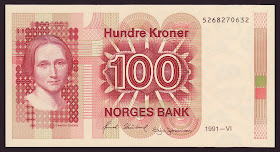Norway Banknotes 100 Kroner Banknote 1991 Camilla Collett
Central Bank of Norway - Norges Bank
Obverse: Portrait of Camilla Collett.
Reverse: Rosette with a fifteenth-century silver buckle.
Issued 1979-1997, No longer valid from 5 September 2008. Number issued: 690 180 000. 145 x 78 mm.
Norwegian Banknotes - Norway Paper Money
1977-1998 Issue
50 Kroner 100 Kroner 500 Kroner 1000 Kroner
Camilla Collett
Jacobine Camilla Collett (born Wergeland) (23 January 1813 – 6 March 1895) was a Norwegian writer, often referred to as the first Norwegian feminist. She was also the younger sister of Norwegian poet Henrik Wergeland, and is recognized as being one of the first contributors to realism in Norwegian literature. Her younger brother was Major General Joseph Frantz Oscar Wergeland.
Camilla was born in Kristiansand, Norway, the daughter of Nicolai Wergeland, a noted theologian, politician, and composer in his time, and Alette née Thaulow. Her brother, was the writer Henrik Wergeland. When Camilla was four, her family moved to Eidsvoll, where her father was made parish priest. Camilla grew up in a literary family, and she became a young diarist, in part because she found life in Eidsvoll dull. She spent most of her teens at a finishing school in Christiansfeld in Denmark.
During a visit to Kristiania she met and fell in love with the poet Johan Sebastian Welhaven, who was also her brother Henrik's literary nemesis. Relations between the three were complicated and in time became legendary in Norwegian Romanticism. Collett was philosophically aligned with the Welhaven side of the debate, and her relationship with her brother may have been uneasy for some time. But there are indications that Camilla carried some resentment toward her father and brother over their opposition to her relationship with Welhaven. She also suffered from health problems during, and in the summer of 1834 her father took her to Paris to regain strength and recover her health.
In any event, her relationship with Welhaven eventually ended, and in 1841 she married Peter Jonas Collett, a prominent politician, literary critic, and member of Intelligenspartiet (the Intelligence party). It was by all accounts a marriage born out of love. As it turned out, he was a supportive and understanding husband with whom Camilla could discuss any topic. She started writing for publication after she married Collett.
Her most famous work is her only novel, Amtmandens Døtre (The District Governor's Daughters) which was published anonymously in two separate parts in 1854 and 1855. The book is considered one of the first political and social realism novels in Norway and deals with the difficulties of being a woman in a patriarchical society in general and forced marriages specifically. It is believed that her personal experiences in life, specifically her relationship with Welhaven, influenced the book. After this book, she wrote very little fiction, but did continue to write essays, polemics, and her memoirs.
Her literary models included female writers such as Rahel Varnhagen and George Sand, as well as Edward Bulwer Lytton and Theodor Mundt. Her style represented a departure from her contemporaries, in that she preferred a more casual, natural tone.
In 1851, after a mere ten years of marriage, Collett suddenly died. This left Camilla to raise four young sons. She was forced to sell her house and never managed to buy a new one again. Her three eldest sons were sent to be raised by relatives. She struggled with personal financial problems for the rest of her life.
She died in Kristiania in 1895.

